Introduction
Farmers look to reduce costs and increase profits, so any factor that increases the efficiency of lamb production should help them meet these objectives. In cattle, the once-calved heifer system was seen to be 50% more efficient than the traditional calf production system. The success of that system depends on several factors such as high quality feed and suitable genotypes to produce high quality offspring, as well as a market for the carcasses. Few studies of this type are available on sheep.
Previous studies have shown that crossbred male lambs grow more rapidly and have better carcass quality than those from hair sheep, which are the most prevalent in tropical counties such as Brazil (McManus et al., 2014). Little information is available on carcass quality in young ewes of different breeds. Carcass composition is an important aspect of meat quality and is usually assessed by the physical dissection of tissues and chemical composition (Santos et al., 2015). Knowledge of tissue composition of animals from different genetic groups is important to manufacture products and helps consumers make an informed decision on the quality of purchased meat, which is largely determined by visual perception (Henchion et al., 2014).
Most studies focus on the quality of slaughtered young male lambs. Nevertheless, cull ewes are important for the profit of the production system (Lôbo et al., 2011) and younger animals usually have better meat quality and higher price. Age can affect carcass composition due to differences in digestive tract content and deposition of adipose tissue (Galvani et al., 2010). Young animals show improved meat quality through rapid muscle growth that provides for the formation of highly soluble collagen (Ito et al., 2012) increasing meat tenderness. In addition, greater body fat leads to higher saturated:unsaturated fatty acid ratio (Webb et al., 1998).
Genetic group also influences carcass quality and fatty acid composition. The use of crosses between breeds results in genotypes with good production traits, adaptability, precocity and finishing characteristics that contribute to improved meat quality and fatty acid profile (Issakowicz et al., 2018).
Therefore, the aim of this study was to evaluate the effect of genetic group, pregnancy, age and their interactions on carcass traits, meat quality and fatty acid profile in sheep meat.
Materials and methods
Ethical considerations
Animal care procedures throughout the study followed protocols approved by the Ethics Committee for Animal Use (ECAU) at the University of Brasilia, number 44568/2009.
Animals and evaluations
Eighty-five ewe lambs (37 Santa Ines, 17 Texel x Santa Ines, 17 Dorper x Santa Ines and 14 Ile de France x Santa Ines) were bred to two White Dorper rams to evaluate the influence of pregnancy on carcass traits. Forty seven females were pregnant at 12 to 13 months of age. All ewes were maintained together throughout the experimental period. The ewes lambed at approximately 17 months of age and suckled their lambs for 60 days. After weaning, all ewes (nulliparous and primiparous) were fattened for slaughter at 21 months of age.
The animals were managed in a semi-intensive system and fed corn silage and Andropogon spp pasture, supplemented with a concentrate mixture (76% corn + 24% soybean meal at a level of 250-300 g/animal/day), and mineral salt and water was offered ad libitum.
After two months of fattening, animals were fasted for 14 hours and slaughtered in a licenced abattoir. The animals were desensitized by electronarcosis, then the jugular vein and carotid artery were sectioned. After bleeding, viscera and head were removed. Three ribs (11th to 13th) were collected from each animal, and these were used to measure the eye muscle area, length and depth of the muscle, subcutaneous fat thickness, color, shear force and cooking losses.
Tissue composition was obtained by manual dissection with a scalpel to separate fat, bone and muscle. Relationships were calculated from tissue weights, such as muscle:bone; muscle:fat and edible portion (muscle + fat/bone), according to McCutcheon et al. (1993).
Eye muscle area (EMA) was determined in the cross section of the Longissimus lumborum muscle of the 12th intercostal space, using a checkered transparent standard (Calnan et al., 2014). Muscle length was the maximum distance in the cross section of the Longissimus lumborum, at the center-lateral direction of the spine. Muscle depth was the largest distance in the cross-section of the Longissimus lumborum, at the dorsal-ventral direction of the animal, perpendicular to muscle length. Fat thickness, was the thickness of the fat cover on the Longissimus lumborum section, taken as the continuation of muscle depth.
Shear force was determined with the same sample used to calculate cooking losses. Samples were cooled in a refrigerator for 24 hours and stored in individual bags. After 24-hour cooling, samples were cut using a stainless steel cylinder (home manufactured) attached to a drill and three cylinders were obtained for each sample. The three cylinders were sheared in the transverse direction of muscle fibers with the aid of Warner Bratzler machine (G-R Manufacturing, New York, NY, United States); averages were obtained and the values expressed in kgf/cm².
A preheated gas oven at 170°C was used to determine cooking losses. The raw meat samples, approximately 1 cm3, were weighed and placed on aluminum trays and weighed again. The samples were placed in the oven and a thermocouple (Exacta, São Paulo, SP, Brazil) placed in the center of the sample. These were then cooked until the thermocouple reached 40 °C. At that time, samples were turned upside down. The samples remained in the oven until the internal temperature of the sample center reached 70 °C. The trays were then removed from the oven, and after cooling, samples were weighed again to calculate cooking loss percentage.
Meat color was measured in the Longissimus lumborum muscle with the aid of a colorimeter (BYK Gardner GmbH, Wesel, NRW, Germany), with integrated spectral pattern, with an D65 illuminant, and 45°/0° viewing angle calibrated for a white, black and green pattern. L*, a* and b* were determined, where (L*) is brightness, (a*) is red level, and (b*) yellow level. Three readings were taken and averaged per meat sample.
Longissimus lumborum muscle samples from these and other 24 lambs (six to twenty one months old) from the same genetic groups were analyzed for fatty acid content. Lipids were extracted using the Bligh and Dyer (1959) method. Dry fat was transmetylated according to Hartman and Lago (1973). The esters formed were analyzed by gas chromatography (Agilent Technologies, Santa Clara, CA, USA; 6890N series) equipped with a capillary column (Supelco, SigmaAldrich®, St Louis, MO, USA), fused silica (100 m long x 0.25 mm internal diameter x 0.2 mm-thick film), and an ionization detector (FID - Agilent Technologies, Santa Clara, CA, USA). The column was heated to 35°C for two minutes and temperature increased 10°C per minute until 150°C, standing for two minutes, then increased by 2°C per minute until 200°C, remaining for two minutes and again increased by 2°C per minute up to 220°C, remaining for 21 minutes, totaling 73.5 minutes. Nitrogen was used as a carrier gas at 0.9 mL/min. The sample volume injected (split mode) was 1μL. The temperature used for the detector (FID) was 280°C. The fatty acids were identified by comparison with reference standard retention times (Supelco FAME Mix® 37, Sigma, Bellefonte, USA). The retention times and areas were automatically computed by GC Solution software (Thermo Fischer Scientific, Waltham, MA, USA).
Using the whole fatty acid profile, the sum of saturated fatty acids (SFA), monounsaturated fatty acids (MUFA), polyunsaturated fatty acids (PUFAs) were calculated, as well as desirable fatty acids, with the equation: DFA = MUFA + PUFAs + C18: 0.
Omega-6/omega-3 (ω6/ω3) relationship was also calculated. Atherogenicity and thrombogenicity indexes were calculated according to Ulbricht and Southgate (1991), and the hypocholesterolemic (h) and hypercholesterolemic (H) fatty acid ratio was calculated according to Santos-Silva et al. (2002).
Statistical analysis
Data were analyzed with the Statistical Analysis System (SAS®) software, version 9.3 (SAS Institute Inc., Cary, NC, USA; 2015) using analysis of variance (GLM) and average comparison by Tukey test with a significance level of 5% and principal component (PRINCOMP), to evaluate the effects of age, genetic group, pregnancy and their interactions on carcass tissue composition, eye muscle area, fat thickness, shear force, cooking losses and fatty acid profile.
Results
No interaction between genetic group and pregnancy was observed for carcass meat quality (Table 1). Muscle and fat weights, as well as muscle length, were affected by genetic group, while fat weight, muscle percentage, fat percentage, fat thickness and cooking loss were affected by pregnancy.
Santa Ines ewes presented carcasses with less muscle weight and muscle length, as well as low fat weight compared to the other breeds (Table 2). Ewes which had passed through pregnancy produced a carcass with less fat weight and percentage, as well as fat thickness, compared to nulliparous ewes.
Table 1 General effects of genetic group, pregnancy and their interactions on carcass quality traits of sheep.
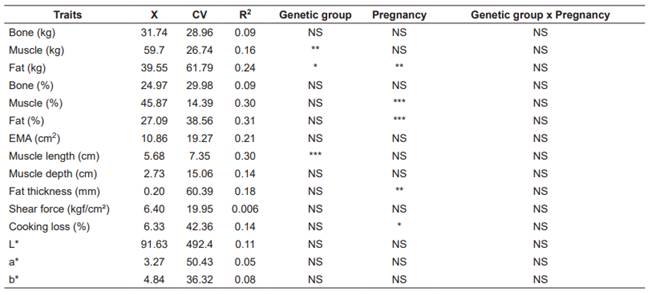
X: Mean; CV: coefficient of variation; R2: coefficient of determination; EMA: eye muscle area; L*: brightness; a*: red level; b*: yellow level; NS: not significant;*: p<0.05; **: p<0.01; ***: p<0.001.
Table 2 Effects of genetic group and pregnancy on meat quality traits of ewes.

EMA: eye muscle area; Means with different letters (a, b, c) within rows differ statistically by the Tukey test (p <0.05).
The first two principal factors explained 33% of all the variation (Figure 1) observed in carcass quality traits. The first eigenvector showed that increasing the eye muscle area (EMA), muscle weight, fat thickness, fat weight and muscle length and depth decreased the shear force and muscle and bone percentages. The second showed that increasing the fat thickness, muscle weight, eye muscle area, fat weight and percentage decreased brightness, yellow level, bone and muscle percentages, as well as shear force.
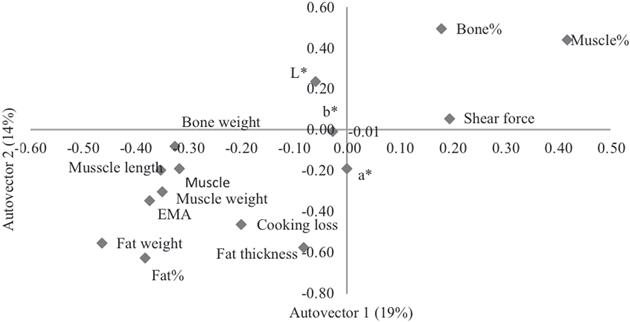
Figure 1 Graphical representation of the first two principal factors for carcass quality traits in ewes. L*: brightness, a*: red content level; b*: yellow content level; EMA: eye muscle area.
Nineteen fatty acids were found in the Longissimus lumborum samples (Table 3). However, C4:0; C8:0; C10:0; C11:0; C12:0; C13:0; C14:0; C15:1; C18: 2n9t; C20:0; C21:0; C20:5n3; C20:3n3; C20:0; C22:0 and C23:0 fatty acids were not observed in any sample. The highest percentages of fatty acids found were stearic (C18:0) and oleic (C18:1n9c) with 51.63 and 19.50%, respectively.
Table 3 General effect of age, genetic group, pregnancy and the interaction between genetic group and pregnancy on the lipid profile of Longissimus lumborum muscle of sheep.
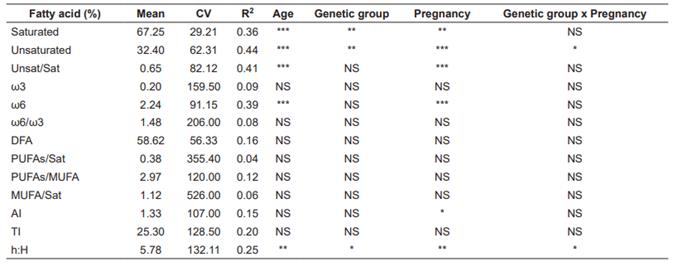
CV: coefficient of variation; R2: coefficient of determination; NS: not significant; *: p<0.05; **: p<0.01; ***: p<0.001.
Saturated fatty acids (Table 4) were found in higher proportion (67.25%) compared to unsaturated (32.40%). The ratio of saturated to unsaturated fatty acids was 0.65. Ile de France and Santa Ines breeds presented higher values for this ratio compared to Dorper and Texel breeds (1.09; 0.67 and 0.50; 0.42, respectively) (Table 5).
Table 4 General effect of age, genetic group, pregnancy and their interactions on the lipid profile of Longissimus lumborum muscle of sheep.
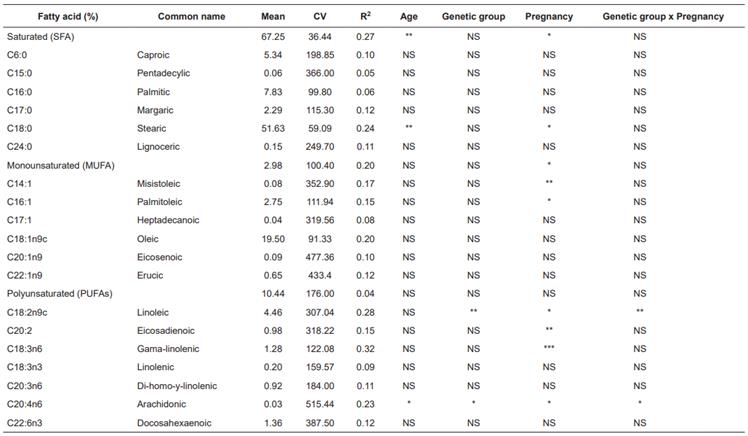
CV: coefficient of variation; R2: coefficient of determination; Unsat/Sat: unsaturated:saturated ratio; ω3: omega-3 acids; ω6: omega-6 acids; ω6/ω3: omega- 6:omega-3 ratio; DFA: desirable fatty acids; PUFAS/SAT: polyunsaturated:saturated ratio; PUFAs/MUFA: polyunsaturated:monounsaturated ratio; MUFA/ SAT: monounsaturated:saturated ratio; AI: atherogenicity index; TI: thrombogenicity index; hH: hypocholesterolemic:hypercholesterolemic ratio; NS: not significant; *: p<0.05; **: p<0.01; ***: p<0.001.
Ile de France crosses (Table 5) had the lowest content of saturated and stearic fatty acid (C18:0) compared to Texel, Dorper and Santa Ines.
Table 5 Effect of genetic group and pregnancy on the lipid profile of Longissimus lumborum muscle of sheep.
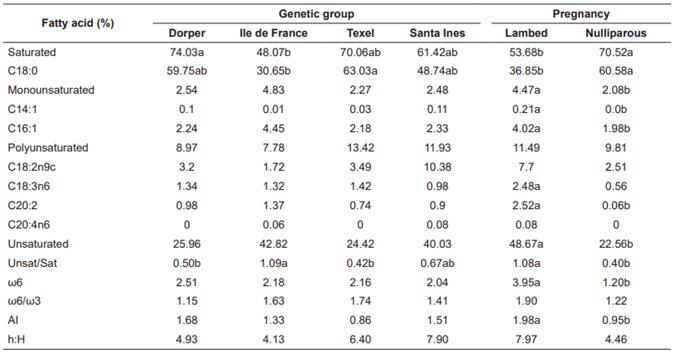
Unsat/Sat: unsaturated:saturated ratio; ω6: omega-6 acids; ω6/ω3: omega-6:omega-3 ratio; AI: atherogenicity index; hH: hypocholesterolemic:hypercholes terolemic ratio; Means with different letters (a, b, c) within rows differ statistically by the Tukey test (p<0.05).
The first two principal factors (Figure 2) explained 39% of the variations in fatty acid profile. The first eigenvector (22%) showed that increase in desirable fatty acids (DFA), saturated fatty acids (SFA) and others such as omega-3 (ω3), omega-6 (ω6), omega-6/ Omega-3 ratio (ω6/ω3), and polyunsaturated fatty acids (PUFAs) was accompanied by decreased unsaturated, monounsaturated (MUFA) and palmitic (C16: 0) acids.
The second eigenvector (17%) showed that increasing desirable fatty acids, omega-3, omega-6, monounsaturated fatty acids (MUFA) and unsaturated fatty acids decreased saturated fatty acids (SFA), thrombogenicity index (TI) and stearic fatty acid (C18: 0).
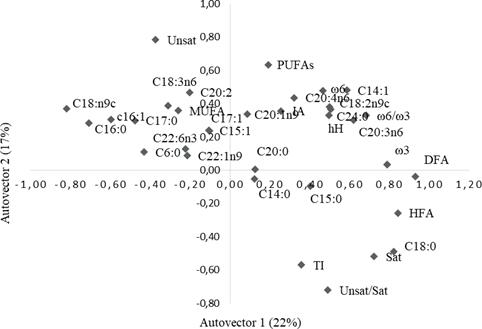
Figure 2 First two principal factors for the fatty acids profile in ewes. Unsat/Sat: unsaturated:saturated ratio; ω3: omega-3 acids; ω6: omega-6 acids; ω6/ω3: omega-6:omega-3 ratio; DFA: desirable fatty acids; PUFAS/SAT: polyunsaturated:saturated ratio; PUFAs/MUFA: polyunsaturated:monounsaturated ratio; MUFA/SAT: monounsaturated:saturated ratio; AI: atherogenicity index; TI: thrombogenicity index; hH: hypocholesterolemic:hypercholesterolemic ratio.
Discussion
Muscle growth is isometric, indicating that higher muscle:fat ratio should be found in young animal carcasses (Lawrence et al., 2012). Fat, which is one of the tissues with the highest variability, either from a quantitative viewpoint or in its distribution, is late developing. Its biological role is energy storage for times of food shortages such as the dry season in central Brazil. Adipose tissue has different distribution in the body composition between non-castrated males, castrated males and females. Females begin depositing fat with lower weights and earlier than castrated and non-castrated males and castrated males at lower weights than non-castrated (Lawrence et al., 2012). Fat is a tissue that increases in percentage with increasing maturity of the animal, resulting in lower feed efficiency, as fat above certain levels is considered undesirable by the consumer. In the present study, genetic group and pregnancy affected fat weight, while fat percentage was affected only by pregnancy. Lower weights and percentages of fat in females after parturition occur because females in gestation and lactation mobilize energy reserves for fetus formation and milk production (Brito el al., 2006).
Eye muscle area is used to predict the amount of carcass muscle, and is the most reliable index of development and size of muscle tissue (Rahaman, 2007). The eye muscle area showed no differences between genetic groups in this study. Souza Júnior et al. (2013), working with male Santa Ines lambs finished in a feedlot, obtained values between 11.40 and 13.43 cm² for eye muscle area. Their values were similar to those obtained in the present study, where Ile de France had the highest area (12.28 cm²) compared to the other breeds. Differences in eye muscle area and muscle length have been observed between genotypes (Burke and Apple, 2007). In the present experiment, significant differences were observed between genetic groups for muscle length. Genetic groups specialized in meat production had higher muscle length compared to Santa Ines breed, demonstrating that meat-purpose animals, as well as crossbreds, have better carcass quality. Therefore, sheep production in Midwest Brazil should use crossbreds, ensuring better carcass quality and quantity.
The animals in the present experiment were pregnant at 12 to 13 months of age and slaughtered at 21 months. At that stage, females are still growing, which explains the higher muscle percentage in females after parturition. The lowest value for cooking losses was obtained in females that, after parturition and weaning, remained in feedlot for 60 days to recover body condition prior to slaughter. Knight et al. (2004) evaluated the influence of fat on cooking losses, finding that animals with lower lipid content had higher cooking losses; lambed females had higher cooking losses compared to non-lambed females. Their results were the opposite from those obtained in the present study, where lambed females had lower cooking losses (5.26%) compared to non-lambed females (6.98%). During cooking, water losses normally occur; however, this value should not be very high because water is related to flavor and meat tenderness (Lazzaroni et al., 2007). High cooking losses are not desirable, because meat becomes dry due to excessive loss of water during the process. In the present experiment, cooking losses were low, averaging 6.33%. Pflanzer and Felicio (2009) observed that carcasses with higher fat deposition resulted in lower water cooking losses. Our cooking losses were lower than literature reports due to longer sample storage and water loss during thawing. Sheep meat can be influenced by storage because of changes in physical and chemical characteristics, and moisture percentage in lamb meat is related to water holding capacity (Lazzaroni et al., 2007). Thus, when water retention properties in muscle are poor, moisture loss, and consequently, weight loss during storage increases (Aberle et al., 2001). Moreover, heavier animals deposit more fat and this leads to lower water content in the carcass (Landin et al., 2011).
The principal component analysis showed, in the second eigenvector, that increased muscle and subcutaneous fat is related to decreased shear force. This relationship has been well established since fat has great influence on meat softness. Animals with good finishing tend to produce more tender meat. In the first eigenvector, decrease in shear force occurs with increased muscle and/or subcutaneous fat.
Saturated fatty acids were present in higher quantities, mainly stearic and palmitic acids. In small ruminants, concentration of saturated fatty acids is higher (67.25%) compared to unsaturated fatty acids (32.40%), as observed in the present study. This is because unsaturated dietary fatty acids are modified by biohydrogenation in the rumen -a way to neutralize the toxic effects of these fatty acids for rumen microorganisms. As a result, saturated fatty acids are absorbed and incorporated into the muscle tissue. However, long chain fatty acids, such as C20 and C22, are not likely to be changed by rumen microorganisms, which favors an increased deposition of these polyunsaturated fatty acids in the muscle, improving nutritional quality of meat (Ponnampalam et al., 2001).
Stearic acid (C18:0) is considered, according to Daley et al. (2010), as hypolipidemic since it lowers cholesterol by rapid conversion of C18 into C18:1. Stearic acid, unlike other saturated fatty acids, reduces serum cholesterol in humans. In contrast, palmitic acid (C16:0) increases cholesterol synthesis, which is a risk factor for cardiovascular disease (Cruz et al., 2011). The mean value for C18:0 observed in the present study (51.63%) was higher than the 14% reported by Andrés et al. (2014), who worked with younger lambs. Older nulliparous females presented higher values. Meat of young and nulliparous females may be considered healthier for consumption.
It is known that excessive consumption of saturated fats may lead to cardiovascular disease and cancer. Unsaturated fats can be consumed in larger quantities; they are considered beneficial for human health since they are associated with lower health risk. The UK health department recommends a dietary polyunsaturated/saturated ratio below 0.4 g/g (Wood et al., 2008). This relationship tends to be close to the desired value in muscle and adipose tissue of ruminants (0.15 and 0.09, respectively). Fat deposition is greater in females and older animals, so it is expected that this ratio also increases. In the present study, the average ratio was 0.38 g/g.
Consumption of polyunsaturated omega-6 (ω6) and omega-3 (ω3) fatty acids is considered essential in the diet of mammals. They are precursors of many important compounds for the proper functioning of the body (Lands, 2005; Nelson et al., 2008). Studies have shown that ω6/ω3 ratio should be below 4. Higher ratios are considered a risk factor for coronary heart disease and cancer, especially due to formation of blood clots, which can lead to heart attacks. Furthermore, high ratios result in decreased production of eicosapentaenoic acid (C20:5), contributing to the development of allergic, inflammatory and cardiovascular diseases (Simopoulos, 2002). The average Omega-6/Omega-3 (ω6/ω3) ratio in the present study was 1.48. Among the genetic groups evaluated there was no difference in omega-6/Omega-3 (ω6/ω3) ratio. It is known that meat of younger females is healthier. According to Wood et al. (2004), lamb has lower omega-6/Omega-3 (ω6/ω3) ratio compared to beef and pork (1.32; 2.11; 7.22), respectively.
The hypocholesterolemic:hypercholesterolem ic (h:H) ratio is based on the functional effects of fatty acids on cholesterol metabolism. It allows for a better nutritional assessment, besides considering the beneficial effects of monounsaturated fatty acids in this ratio. Stearic acid (C18:0), although a saturated acid, does not increase blood cholesterol (Daley et al., 2010). The average of this fatty acid observed in the present study (5.78%) was higher than that obtained by Costa et al. (2009), who worked with lambs of different breeds. In regard to genetic group, Santa Ines had the highest value (7.90%), followed by Texel (6.40%), Dorper (4.93%) and Ile de France (4.13%) crosses. These values confirm that meat-type animals produce larger carcasses, which are nutritionally more beneficial for human consumption (Sen et al., 2004). The higher the hypocholesterolemic:hypercholeste rolemic ratio (h:H), considering the specific effects of fatty acids on cholesterol metabolism, the more suitable is the oil or fat from a nutritional standpoint (Guimarães et al., 2013).
Atherogenicity (AI) and thrombogenicity (TI) indexes indicate the overall dietary lipid quality and their potential effect on the development of coronary heart disease, since their calculations take into account saturated, monounsaturated and polyunsaturated fatty acids (Ulbricht and Southgate, 1991). The average atherogenicity index (AI) was 1.33 in the present study. Greater variation was observed for genetic group, with 1.68 for Dorper, 1.33 for Ile de France, 0.86 for Texel and 1.51 for Santa Ines. The thrombogenicity index (TI) was 31.92 for Dorper, 26.46 for Ile de France, 36.71 for Texel and 22.05 for Santa Ines. This trait is related to the genetic group. In this study, Dorper and Texel breeds showed less healthy meat as low values are desired for atherogenicity and thrombogenicity indexes (Ulbricht and Southgate, 1991). These ratios, related with pro and anti-atherogenic acids, indicate potential stimulus for platelet aggregation, i.e., the smaller the atherogenicity and thrombogenicity index values, the greater the amount of anti-atherogenic fatty acids present in fats, and hence the greater the potential for preventing the onset of coronary heart disease (Singh et al., 2010). There are no recommended values for these indices; however, lower values indicate a more favorable ratio of fatty acids and higher values suggest that fat consumption lead to health problems (Nozaki et al., 2012). In the present study, pregnancy influenced atherogenicity index. Nulliparous females had lower values compared to lambed females (0.95 and 1.98, respectively). Nulliparous females also had less fat.
Stearic fatty acid (C18:0) is considered desirable in high amounts in meat. The correlation between this acid and muscle fat was negative, indicating that excessive increase in fat decreases stearic acid (C18:0). This result corroborates the use type meat animals as the Dorper breed. This breed tends to have a higher lean carcass and, therefore, less fat (Waaland Combrinck, 2000). However, the correlation of C18:0 with subcutaneous fat was positive and low. With the increase in subcutaneous fat, which is important for carcass finishing and flavor, stearic acid slightly increases. This provides a more flavorful and nutritional meat, since consuming this fat could lower blood cholesterol.
Although fat in meat is unpopular among consumers in terms of unhealthy life habits, it contributes to meat quality and has nutritional value (Webb and O’Neill, 2008). Its correlation with healthy fatty acids, omega-3, omega-6 and omega-6/omega-3 ratio was negative and low in our experiment. It is known that excess fat, in addition to being visually unattractive for the consumer when choosing meat, does not bring health benefits. Primiparous ewes fatten for slaughter at 21 months of age resulted in carcasses with less fat.
In conclusion, pregnancy influenced fat (weight, percentage and thickness) as well as muscle percentage and cooking losses, with females that had been pregnant being fatter. Genetic groups used for meat production have better performance in terms of commercial cuts compared to Santa Ines breed. Younger and nulliparous females have better carcass quality in terms of fatty acid composition.














